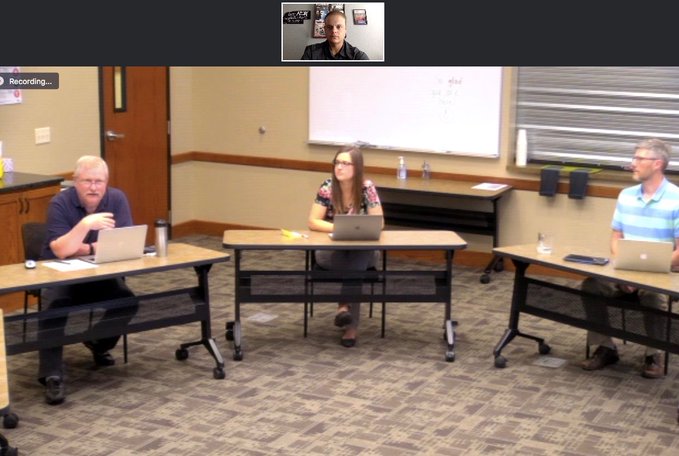Service Units Support: After rising to spring's challenges, ESU 9 focuses on adaptability heading into fall
Service Units Support: After rising to spring's challenges, ESU 9 focuses on adaptability heading into fall
By Tyler Dahlgren
Adhering to the one-word action plan made famous by best-selling author Jon Gordon, Drew Harris’s selection last summer before his first year as ESU 9 Administrator ended up being not only remarkably fitting, but absolutely necessary.
“My guiding word was opportunity, and I picked that at the start of the school year,” said Harris, who assumed his new role at the service unit in Hastings after 35 years in education, the last 21 as a superintendent.
After the Coronavirus pandemic flipped the education world upside down, and as ESU 9 formulated action plans of their own to assist their member school districts in the pandemic’s new normal, Harris came back to that word. And guide him, it did.
“I thought that was interesting, because what an opportunity this presented,” Harris said. “A chance to rise up and learn and meet the needs of our schools and adapt what we were doing to do so. Truly, what an opportunity.”
Which leads us to Harris’s guiding word for the 2020-21 school year, whatever it ends up looking like.
“Adaptability,” Harris said. “We’re going to have to adapt to what’s coming at us, and, as we learn more, we’re going to have to adapt in the ways we provide services. We’re going to have to adjust our schedules and adjust our transportation. We’re going to have to provide flexibility in our planning so that we can meet our schools’ evolving needs.”
ESU 9 staff is utilizing this summer to both assess what was accomplished in the months of March, April and May, and get a leg up in preparing for the fall.
“We’re taking the summer to make sure that we’ve done an adequate amount of planning, and that we’re as ready as we can be for what will be an unpredictable scenario come the fall,” said ESU 9 Technology Director Gary Needham, who just completed his eighth year at the service unit.
Needham spent time working for schools earlier in his career, both at large and small districts, and his first job out of college was providing tech support for ESU 10. For tech directors, there’s an endless pursuit of new knowledge and new technology. Needham's previous experience helped him relate to what educators were experiencing during the closures. It helped, too, that ESU 9 dove in to exploring expansive distance learning in February, a month before the pandemic closed schools nationwide.
“It wasn’t that we knew it was coming and it would get to the point where schools would have to close, but we started looking at the contingency of ‘What if we have an infection in the office before we started helping schools prep? What would it take if we had to work from home? Could we continue operations?’” Needham asked. “We knew we had the technology to make it happen, and then it was a matter of being able to put the pieces together quickly.”
The pieces did come together quickly. Frankly, they had to.
Needham created more than 150 new Zoom accounts for ESU 9’s service region, a number that will continue to grow into the new school year, and assisted districts in becoming acclimated to the now-essential tool. Two telephone companies are headquartered within ESU 9’s territory, and Needham assisted schools in communicating with those companies to ensure access was provided for unconnected families at little to no charge.
“The telephone companies and local internet providers felt like serving their local communities was really important, and they made sure those connections were made,” said Needham.
While Harris hosted and facilitated weekly superintendent meetings, he also worked with local health departments and provided essential updates for member schools and area day care facilities. He was a school representative on the Adams County Executive Committee and participated in the ACNW (Adams, Clay, Nuckolls, Webster Counties) Crisis Assistance Committee. The knowledge he acquired from those meetings was extensive and incredibly valuable.
“Communication has really been a focus for us this year, and along with that, developing good relationships with our schools and our superintendents,” said Harris, who, right before this discussion held a meeting that was attended by all 14 area superintendents. “I think that was an essential component of this.”
Business Manager Emily Burr, meanwhile, hosted bookkeeper meetings for area schools to discuss coding, new employment laws, payroll and other changes brought forth during the pandemic. ESU 9 kept their offices open throughout the school year and into the summer, and it was Burr who created employee schedules and coordinated in-office operations. Though her first year ended with a wicked curveball, Burr sees a lot of good coming from those challenges.
“I have superintendents that have my cell number now and they’re not afraid to use it, and I’m not sure that would’ve happened before this,” Burr said. “Relationships and communication have changed for the better because of these circumstances.”
Harris lauds the work done by his entire staff, including Professional Development Director Jackie Ediger and her team, which hosted and facilitated meetings for grade-level and content-area groups of teachers (more than 750 participated) and constantly continues to both funnel resources and connect area educators to share best practices. Special Services Director Joe Haney has tirelessly assisted early childhood and visually and hearing impaired educators in the area, and his department has facilitated speech language pathology services and mental health consultations in the pandemic, too. Instruction never stopped, a testament to the fortitude of the entire ESU 9 staff.
“Everybody realized, ‘Hey, we can’t do this by ourselves. We have to work together in this,’” said Harris. “It’s amazing, how everybody stepped up. You get in a bind and people rise to their best. They give what they have to give to make things work.”
It wasn’t just the ESU 9 staff who viewed the challenging circumstances as a tremendous opportunity for growth.
“Teachers that had taught one way for 30 years, within two weeks totally transformed their educational process,” remarked Harris. “People rose to the occasion. They learned to utilize tools they weren't previously familiar with, and they kept their heads up and were positive throughout it all.”
After all, Harris said, we’re all in this together.
“I’m proud of the response our school districts showed in trying to make quality education continue to happen.”



